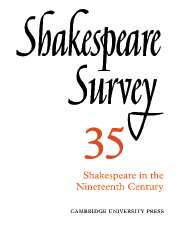Book contents
- Frontmatter
- Before the Shakespeare Revolution: Developments in the Study of Nineteenth-Century Shakespearian Production
- The Meininger Company and English Shakespeare
- Shakespeare at the Burgtheater: From Heinrich Anschütz to Josef Kainz
- Shakespeare on the Melbourne Stage, 1843-61
- Shakespeare in Hazlitt’s Theatre Criticism
- Characterization of the Four Young Lovers in A Midsummer Night’s Dream
- Queenly Shadows: On Mediation in Two Comedies
- Language, Theme, and Character in Twelfth Night
- The Art of the Comic Duologue in Three Plays by Shakespeare
- ‘Spanish’ Othello: The Making of Shakespeare’s Moor
- Ferdinand and Miranda at Chess
- Shakespeare’s Latin Citations: The Editorial Problem
- The Theatre at Christ Church, Oxford, in 1605
- Interpretations of Shakespearian Comedy, 1981
- The Year's Contributions to Shakespearian Study 1 Critical Studies
- 2 Shakespeare’s Life, Times and Stage
- 3 Textual Studies
- Index
- Plate Section
Interpretations of Shakespearian Comedy, 1981
Published online by Cambridge University Press: 28 March 2007
- Frontmatter
- Before the Shakespeare Revolution: Developments in the Study of Nineteenth-Century Shakespearian Production
- The Meininger Company and English Shakespeare
- Shakespeare at the Burgtheater: From Heinrich Anschütz to Josef Kainz
- Shakespeare on the Melbourne Stage, 1843-61
- Shakespeare in Hazlitt’s Theatre Criticism
- Characterization of the Four Young Lovers in A Midsummer Night’s Dream
- Queenly Shadows: On Mediation in Two Comedies
- Language, Theme, and Character in Twelfth Night
- The Art of the Comic Duologue in Three Plays by Shakespeare
- ‘Spanish’ Othello: The Making of Shakespeare’s Moor
- Ferdinand and Miranda at Chess
- Shakespeare’s Latin Citations: The Editorial Problem
- The Theatre at Christ Church, Oxford, in 1605
- Interpretations of Shakespearian Comedy, 1981
- The Year's Contributions to Shakespearian Study 1 Critical Studies
- 2 Shakespeare’s Life, Times and Stage
- 3 Textual Studies
- Index
- Plate Section
Summary
The major productions in the summer of 1981 represented the entire range of Shakespearian comedy: The Two Gentlemen of Verona, The Merchant of Venice, A Midsummer Night’s Dream and The Winter’s Tale at Stratford; Troilus and Cressida at the Aldwych Theatre; Measure for Measure and Much Ado About Nothing at the National Theatre; and for good measure Britten’s A Midsummer Night’s Dream at Glyndebourne. The interpretations ranged even more widely in approach and in achievement.
John Barton's Stratford Merchant of Venice was an expansion for the main stage of his outstanding 1978 studio version which I reviewed in detail in Shakespeare Survey 32. In order to achieve some of the concentration of that staging, all the action was contained on a large circular platform at the very front of the stage, with a powerful overhead lamp dead centre which was used to emphasize moments of emotional intensity. Behind this hung a huge translucent canopy, through which could be glimpsed gondola mooring-posts for Venice or leafy boughs for Belmont. As before, the costumes were Chekovian/Edwardian, and much of the business was carried over; but the impact of the play as a whole was significantly different, and more uneven.
- Type
- Chapter
- Information
- Shakespeare Survey , pp. 141 - 152Publisher: Cambridge University PressPrint publication year: 1982

